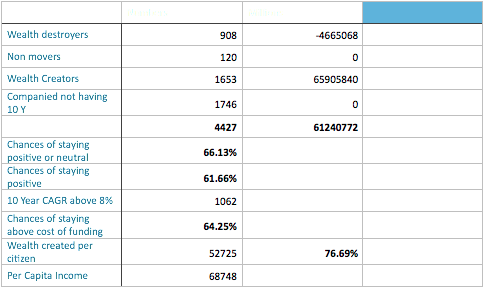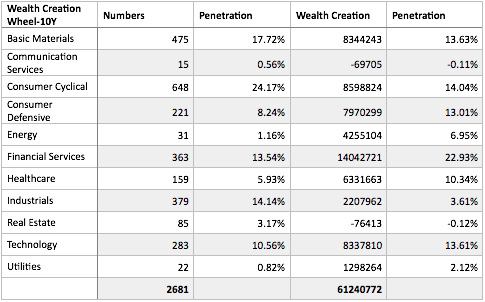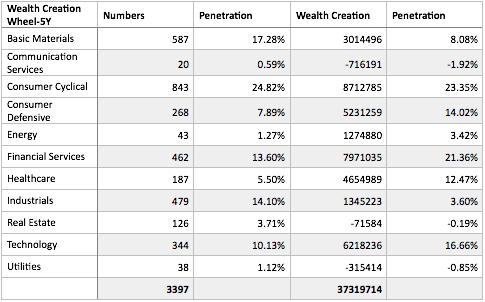The Jewels Of India- Introspecting “which won the Alexander” (I- Tapping the source)
The name must be sounding as if some jeweller is trying to sell you few immaculate pieces of rare stones unearthed from Moghul emperor building,with a possibility of event happening again in 100 years!
This is my inward looking journey of studying the Alexander (winners) of last decade in Indian stock market. Why such unusual way of backward rolling, what I will gain out by doing something eventually may not lead anywhere. Are not there others who would have done it and what kingdom they could over turn for themselves? Am I not better off continuing focussing on time tested investing philosophy (value/growth) and continue to enhance the capabilities there of.
If you ask me, you are right about these questions and many more. But now I don’t think you need a model framework which includes helmet to war dress and fit for all so that everyone can look like Alexander. Opportunities were always unique, problems as well and I continue to search the unanswered questions where I was getting edgy. You continue to do as well in your own way.
The “Jewels of India” is an attempted ongoing project on working backwards the performers of Indian market during last ten years (performers in the sense of price) and directing these winners to look out for any standard patterns. Now these patterns so far I have kept open ended but nevertheless going to include investment philosophy, fundamental behaviour of these stocks vis-a-vis price, technical indicators (I am not good at these!), chunking themes( either exceptions investing, value investing or growth or any other name we like). I will jot down the kind of KPI we are hammering down for now. I am immensely thankful to my friends who has been kind enough to explain the Morningstar classification, pointers to look at, debates that fried the bheja and reminded me how after 21 years of investing sand box still remain fragile, so much that sometimes sounds nothing more than a whisper!
But before I jump into the beginning of specifics of this project, I want to bring out a pre-cursor of an interaction with an multifaceted personality few months back which shaken me off the collar.
Here it is, I hope you enjoy it as well:
If you don’t mind can I ask your age? This is after 2 and half hours in a cosy restaurant located in MG Road, Bengaluru. I was almost in a trance state post the high intensity conversation. Mr P sipped a bit of water and replied I am 53. We continued the conversation for another hour almost before I headed to home in an evening with traffic chaos and minor drizzle. As I started rewind myself on roads of Bengaluru I realised some one just told me he left a job at 32, made millions in 15 years and lost everything in 90 days. By 47 he was bankrupt, made an equally strong come back. I will come very soon on Mr P and his lessons of “applied behavioural finance”.
Mr P passed out as graduate in engineering ( Mechanical Engineering from Indian Institute of Technology, Mumbai) followed by a MBA from Jamnalal Bajaj. He recounts despite being an average student still he could crack it, he thought he just invented a formula….rules are for crowd….not applicable for super men and women. He worked for 7 years and elevated to ranks of senior management in a fortune 30 company, a feat again very few does it. This prompted him to go out of the way and start risking trade off with customers and suppliers, breaking all cardinal rules of traditional corporate, only to be fired by ethical committee on 8th year. At 32 he said I was back to square one. World seems to be cruel and evening were darker than ever before. The saving grace was Mr P’s casual venture into equity investing. After forced to a hole, he thought I can go back and start hunting another job……but somehow my ego didn’t allow me to repeat what he feels a master stroke blurred by corporate ethics.
He says I was an avid fan of Warren Buffett and Chandrakant Sampat, but fan following wont fetch you a livelihood. Then follows his journey from value investing, to what he calls speculation, a bankruptcy and finally rise from rubbles from as late as 47. I could spot all excitement ingredients from the conversation, every number he was uttering was millions; even fancied a luxury caravan living to loosing Bose music system and office apparatus.
There are tonnes to learn from these unsung heroes, I am forced to comeback to my table……thinking how to manage The Black Swan, the stop loss ……more importantly the behavioural finance.
A lot of mental strips he has suggested me to adopt from the book “What I learned by loosing a million dollar”. A book six years back I passed it as casual read, this time I finished 3 times in 9 days!
Below is abstract of Mr P’s advise customised:
Personalising success sets people up for disastrous failure. It didn’t even spare Henry Ford or IBM. Sometimes we fail to admit we are plain lucky. The easiest way to lose success is getting convinced that you are successful. I was convinced I am successful, I am stand apart from crowd. Whether the IIT or Fortune 30 or a even Vice President. Come on no one becomes a VP at 32 in a 100 Billion dollar plus MNC! I must be something!!
He continued his journey, after being fired from job I started rebuilding my kingdom again. This time I became a trader (actually a speculator) and within 2 years I was raking moolah. Even as much as 10-15 lacs a day was sometime a normal incident. Be it soya bean, sugar , oil or stock market I was all over place. I joined a coveted club in Mumbai with proximities to who’s and who’s of dalal street. Life was on an elevator surrounding unstoppable dreams. Then came big bucks, 15 days I cracked a couple of Crores , prompted me to hire a Mercedes customised Caravan and set out for a month’s journey all across Maharashtra. More than leisure it was a display of wealth and might. I ridiculed all sort of people who complains life is cruel, jobs are scarce or even Ginni coefficient is rising.
Then came the day where I told my partner this time we will erase Rakesh Jhunjhunwala from records and replace our name. The bet riding was too high and working in our favour. We continue with juggernaut of success, all of a sudden market started sputtering downwards. I was Napoleon of Dalal Street, we can do….we can do…The margins kept getting increased as the position limit falls further. I started getting irritated at wife and kids, couldn’t slept for days….lost 18 kg weights. As margin continues to rise, I borrowed money….till one fine morning I realised I cant afford any more. Still I didn’t had the courage to close the position. The position was forcibly closed by dealer and my entire office, properties and everything saleable being snatched away. From a few dozen of crore rupees I was reduced to a street beggar….all in a matter of 90 days.
It was half past 9 in night, I came out of Worli (Mumbai) office and started driving towards Pune expressway. The only solution came to mind is to dash off the car into the sea in such a way so that it looks like an accident and my family get paid off the insurance. I couldn’t muster my courage in front of so many people and started moving to Pune. Till the time realise a cop stopped me on highway. He shouted immediately do you know what speed you are driving the car? I replied immediately must be 75-80. No you are driving at 15 kms per hour and a nuisance on highway , creating obstacles for others!! (here I guess he was trying to impersonate Jim Paul!)
I came back to home and remain mum for a month or so before gathering courage again. I must fight! But with whom and on what?
This time I went back to experts and started reading, meeting all I could. I observed one thing very clearly; there are many ways of winning and all of them differ with each other. When it comes to loosing all are on same page!
I sort of organised the conversation into an questionnaire format though it didn’t happen in exact sequence.
Question: So you give credit only to luck? All your pedigree, intellectualism didn’t play a role in the spectacular come back?
Mr. P: I didn’t say that, all I was emphasising luck play a role in everything. Accept it rather reconciling every bit of success to all the mavericks things you think you possess.
Question: Can I say a value investor turned to trader, but still you have strong portfolio stocks?
Mr. P: I am not aware of who defines value investing or any other form of investing philosophy for whom? I think was investing in business earlier, now trying to behave like a business man.
Question: Can you please elaborate what is behaving like business man?
Mr. P: When you are doing research, thinking, or any other act before putting money you are not doing business. The moment you put money you need to behave like business man and accept things can either go wrong or right and you must have a plan in both the case.
Question: Did you not feel like going back to job after the debacle? I mean after all you are IITian , anyone could have hired you.
Mr. P: Career means an occupation taken for a significant period of life with opportunities and progress. My debacle was financial turmoil, what career has to do with it?
Question:Quite interesting, a lot of people successful investor speak arrogantly though they think are polite. Is that how you feel?
Mr. P: It only happens when you start thinking bigger than whom you are talking to. Start talking to yourself, will realise what you are.
Question: Do you think any particular investment philosophy is a must for succeeding in market place?
Mr. P: Don’t boil the ocean to find out a rocket science, create a method and stick to it. Don’t worry you have to change at least a million time before you die. Certain things come naturally.
Few more questions may not be relevant at this point of time will stamp them later. This forced me to look at a changing view point. And part of the chunking an inward looking introspection was order of the time.
I will jot down the approach, methodology , assumptions etc in next bucket. Meanwhile an indication of analytic strips below:
- India market overview and classification (cyclical, defensive, sensitive and further two levels breakdown)
- The winners and their classification
- Price analytics of winner (fundamental and speculation growth)
- Relative price analysis behaviour against growth (MC/OP, MC/Sales, P/B, P/FCF)
- Margin analysis (against price and against sectoral competition)
- Return behaviour with price (ROE, ROIC, ROA etc)
- Financial health behaviour with price (balance sheet management KPI)
- Management action and price behaviour (unwanted bonus, over split, dividend, buy back, non organic investments)
- Growth behaviour with price (acceleration engine- revenue, profit; both individual and sectoral)
- Cash flow management with price behaviour
- Efficiency with price behaviour
- Identifiable competitive advantage, competitive force against company
- Identifiable uncontested market place (Blue Ocean) against company
- Favourable base case valuation (asset, earning power, franchise) and price behaviour
- Capital allocation (other than management action such as growth capex) and price behaviour. I may merge with management action.
- The technical trends ! (to my limited knowledge)
- The growth investing themes, business strategy if they can be identified to a company (e.g. unbundling, bait and hook, the long shot, freemium).
This is a good amount of work for me, will start off loading one by one. A couple of strips are ready, will sanitise and come back soon.
Do let me know questions if any and suggestions, can include them back to practice notes.
Good wishes
Talk to you soon.








 I thought Jewels are precious stones and they don’t change easily whether Manmohan or Modi at helm and/or just in 4 years…or coatings can be changed… Now I am trying to look underneath coatings and want experts like you to help us to scratch it and tell ‘real’ jewels
I thought Jewels are precious stones and they don’t change easily whether Manmohan or Modi at helm and/or just in 4 years…or coatings can be changed… Now I am trying to look underneath coatings and want experts like you to help us to scratch it and tell ‘real’ jewels  Those are the ones the wise men will buy, by selling not so precious jewels which can perish on the way! They survived and improved the shine on the way and will continue to improve it and expected to continue to do so for long, so that anyone who possess it would be blessed.
Those are the ones the wise men will buy, by selling not so precious jewels which can perish on the way! They survived and improved the shine on the way and will continue to improve it and expected to continue to do so for long, so that anyone who possess it would be blessed.